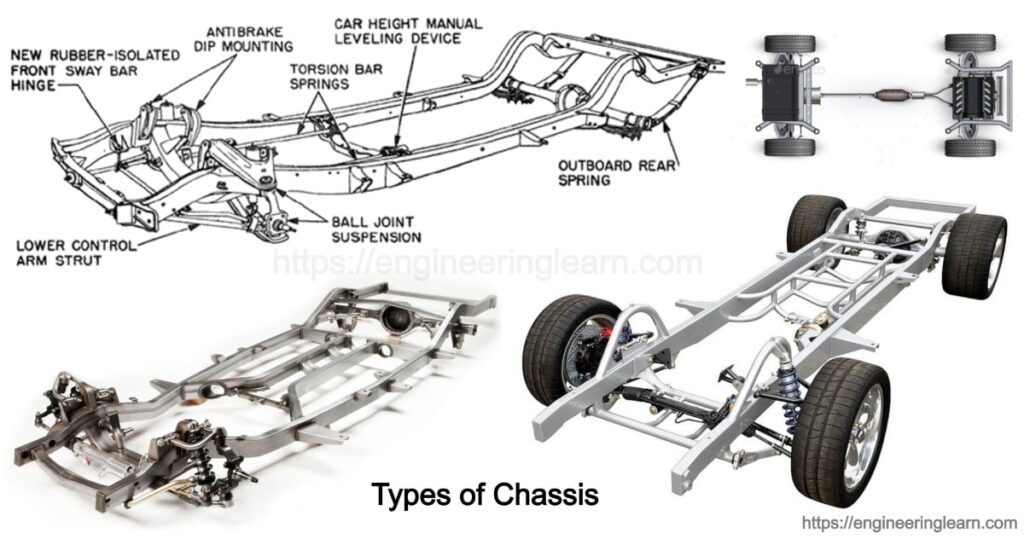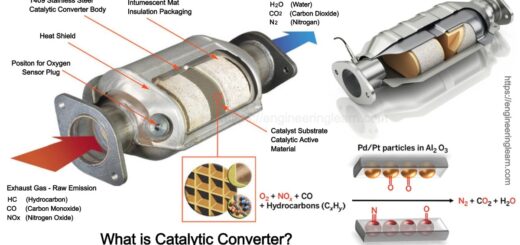Types of Chassis – Components, Function, Design & Construction [Complete Guide]

What is Car Chassis?
Types of Chassis in Car: Components, Function, Design & Construction :- Chassis is derived from French term which means frame or main structure of a vehicle. In automobile chassis is the external structure of the vehicle which houses the all the components of the vehicle and mounted on the wheels of vehicle with help of frame. In simple words automobile chassis is a complete vehicle without a body. It is just like a complete human without a dress. Frame is an integral part of chassis on which the whole body of vehicle is mounted.
Components of Chassis
- Frame
- Front suspension
- Steering mechanism
- Silencer
- Storage battery
- Rear springs
- Road wheels
- Shock absorbers
- Brakes and braking system
- Propeller shaft
- Engine, clutch, gearbox
- Radiator
- Fuel tank
Function of Chassis
- To support the body weight and loads acting on vehicle
- To support the accessories of vehicle
- To support the power system and control system
- To provide space for the passengers
- To get the perfect aerodynamic design to avoid drag
- To integrate the whole parts of the vehicle
Construction of Chassis
A typical chassis frame is shown in figure. Here the long sections which are located on either side are called longitudinal members. These longitudinal or side members are joined together with cross members with the help of rivets or bolts. Generally, five or six cross members are used to give good strength and stability to the chassis. Sometimes diagonal cross bracing is also provided for torsional rigidity.
The longitudinal members are upswept in the front and rear to provide the space for movement of axle. It also helps in keeping the frame height low also the frame tapers from rear to front to provide better steering lock by providing a smaller turning circle. The brackets are provided in the frame to support the body also for mounting different parts such as suspension springs, engine, brake shaft etc.
The extended part of chassis frame over the front axle is known as front overhang. Whereas beyond the back axle is known as rear overhang. The engine, clutch and transmission are all bolted together into an assembly and are mounted usually on the front end of this frame by means of rubber blocks. These rubber blocks help in isolating the engine from road shocks and also isolating the vehicle from engine vibrations. All these members used in making the chassis frame are made up of pressed steel.
Types of Chassis
A) Based on Engine Location: ( Types of Chassis )
1. Conventional Chassis
In this type of chassis engine is fitted in front of driver cabin making the driver sit quiet far from the front axle. Due to this driver is unable to see the road just in front of tyres. The portion of the chassis where engine is fitted can’t be utilized for carrying passengers or goods.
2. Semi Forward Chassis
Here engine is fitted in such a way that half of it is in driver’s cabin and remaining half is in front of drivers’ cabin. This portion of chassis where engine is fitted inside drivers’ cabin can be utilized.
3. Full forward or Bus Chassis
Here complete engine is mounted inside the driver’s cabin and driver sits just above the front wheels and is able to see the road just in front of the tyres completely.
4. Centre Engine Chassis
It is also known as mid-engine chassis. In this engine is mounted between front wheels and rear wheels. Since the weight of the cars shifts under the acceleration this arrangement further improves wheel grip and curved body can be designed with greater aerodynamic efficiency.
5. Rear Engine Chassis
Here engine’s Centre of gravity is behind the rear wheels. This is mostly seen in low floor buses wheels remaining space can be used for passengers and luggage.
B) Based on Assembly: ( Types of Chassis )
1. Conventional Chassis
In conventional chassis the longitudinal members or side members are joined by four or five cross members over which all the body and all the components are installed.
2. Integral Chassis
This is also called as frameless chassis. The body shell and under body are welded into a single unit which helps in decreasing the overall weight. Due to the elimination of longer frame it is cheaper. The only disadvantage is its difficulty to repair.
3. Semi Integral Chassis
In the semi integral chassis, the engine is installed on a frame. The remaining portion is frameless. This is because when the vehicle suffers from any accident then only the front portion can be repaired.
C) Based on Frame: ( Types of Chassis )
1. Ladder Frame
This frame is similar to the shape of a ladder. It has two longitudinal members also called as side members joined by four or five lateral members or cross members.
2. Backbone Frame
In this frame instead of two-dimensional ladder, it consists of strong tubular backbone which bears most of the loads.
3. Tubular Space Frame
Space frames are all about tubes held together in compression and tension using 3D pyramid style structure and diagonally brace tube boxes. A tube space frame is capable of holding its shape even if the joints between tubes are hinges.
4. Monocoque Frame
In Greek mono means single and in French coque means shell. It is a construction technique that supports structural loads by using objects external skin.
5. Aluminum Space Frame
As traditional steel monocoque chassis is heavier. Hence, car makers turned to replace steel with aluminum and everything is same as monocoque.
6. ULASAB Frame
Aluminum space frame is heavier, so American steel manufacturers hide Porche engineering services to develop a new kind of steel monocoque technology called ultra light steel body monocoque frame.
7. Carbon Fibre Frame
Carbon Fiber monocoque frame is a monocoque type frame made of carbon fibre. It has superior rigidity to weight ratio.













